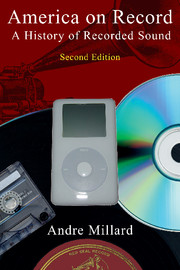Book contents
- Frontmatter
- Dedication
- Contents
- Preface to the second edition
- Preface to the first edition
- Introduction
- Part One The acoustic era
- Part Two The electrical era
- 6 The machines
- 7 Competing technologies
- 8 Empires of sound
- 9 Swing and the mass audience
- 10 High fidelity at last
- 11 Rock'n'roll and the revolution in music
- 12 The record
- 13 The studio
- 14 Perfecting studio recording
- 15 The cassette culture
- Part Three The digital era
- Abbreviations used in the notes
- Notes
- Select discography
- Select bibliography
- Subject index
- Recordings index
- Motion picture index
12 - The record
from Part Two - The electrical era
Published online by Cambridge University Press: 05 February 2015
- Frontmatter
- Dedication
- Contents
- Preface to the second edition
- Preface to the first edition
- Introduction
- Part One The acoustic era
- Part Two The electrical era
- 6 The machines
- 7 Competing technologies
- 8 Empires of sound
- 9 Swing and the mass audience
- 10 High fidelity at last
- 11 Rock'n'roll and the revolution in music
- 12 The record
- 13 The studio
- 14 Perfecting studio recording
- 15 The cassette culture
- Part Three The digital era
- Abbreviations used in the notes
- Notes
- Select discography
- Select bibliography
- Subject index
- Recordings index
- Motion picture index
Summary
Previous chapters have described how the recording became a new consumer product, a status symbol that conferred good taste on the listener, and a vehicle for the diffusion of American popular culture. It could also serve as a cultural artifact. Thomas Edison toyed with the idea of using the phonograph to record the voices of Victorian worthies, in order that their words of wisdom could be saved for posterity, but the program was forgotten when the commercial potential of recorded music was discovered. It was left to the academic community to use recorded sound to save a people's cultural heritage.
Anthropologists took Edison phonographs out west to record the songs and music of the American Indians. J. W. Fewkes of Harvard University made the first records in the 1890s. The phonograph played a vital part in preserving the musical folklore of America, creating ethnomusicology as a separate branch of anthropology. Ethnomusicologists travelled the continent, from the frozen north to the steamy jungles of central America, in search of the musical folklore of the indigenous population. They recorded Eskimos, Indians, and the descendants of the Maya. While the gramophone and the disc took over the commercial recording business, anthropologists preferred the spring-motor phonograph because it was sturdy and stood up to the demands of field work.
Native American music was sporadically recorded by the record companies: Emile Berliner made some recordings of Indians in the 1890s, Victor made some more around 1905, the Gennett Company distributed records of Hopi Indians in 1925, and Edison committed the sounds of the Seminoles to wax record in 1926 so that future generations could study them.
In the early years of the twentieth century, a heavy Edison machine was again tied onto a saddle and taken out to record the ethnic music of the far West, but this time it was cowboy songs that were to be saved on the phonograph's cylinder.
- Type
- Chapter
- Information
- America on RecordA History of Recorded Sound, pp. 244 - 257Publisher: Cambridge University PressPrint publication year: 2005



